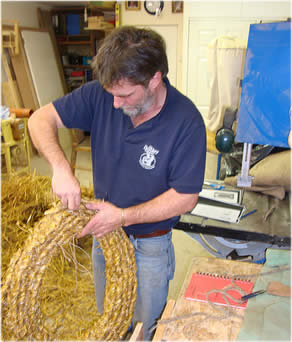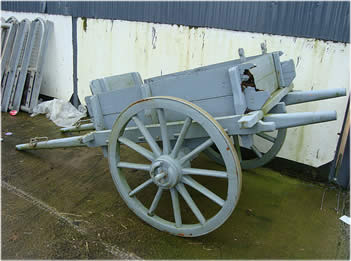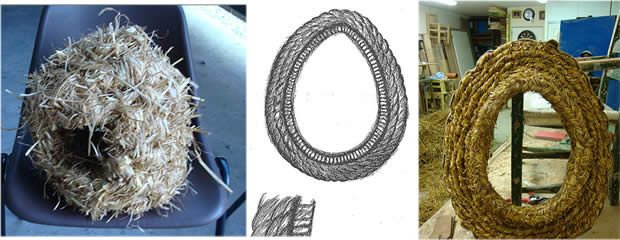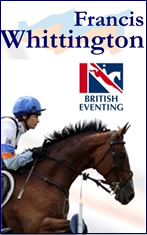
Horseytalk.net Special Interview
Chris Garrett
CLUTCHING AT STRAWS...
A harness maker talks about his craft, how he started and how he has made more harnesses in more countries than he can remember
 Says Chris Garrett
Says Chris Garrett
I’m fascinated by old crafts, always have been and that’s probably one of the main reasons I became a harness maker in the first place. Since I started working overseas about twelve years ago I’ve delved into local crafts at every opportunity. There is actually a good reason for this - it is much easier to get a group to accept a new idea, such as good harness, if it looks familiar, if it is something that they can understand a little even at first glance.
I have made harness in more countries than I can remember now, all of it in the last 6 years at least, made using techniques and crafts that I have picked up from my students. In fact I was so worried about losing my English harness skills that I grabbed a chance to spend some time with a well known harness maker at the end of last year and get some practice in. Whilst I was there I noticed a book about Irish basket making by Joe Hogan. Imagine my surprise when I came across a picture showing a whole set of harness made entirely from straw in its pages. Even more exciting for me was to see a picture of a full collar.
If you think back to the days of working horses in England you’ll conjure up a picture of a heavy horse in all its harness, and always with a full collar. Nowadays we use a lot of breast collars, which is essentially a couple of straps fixed together. They are easier and cheaper to make and since there are very few horses or donkeys actually in full time hard work they are sufficient. But if you are one of the few still working seriously with equines then you would be using some form of full collar. The reason is simple, they are a lot more efficient, allowing the horse, mule or donkey to work much more effectively for a lot less effort. The problem with them is that they are difficult to make well, maintain and repair, they don’t transfer well from one animal to the next either. In Mexico and Egypt they do make full collars anyway but the other countries don’t and we’ve never been able to think about introducing them for the reasons just laid out... until now.
 The pictures I saw in Joe’s excellent book led me on a trail, first to him, then to Seamus Mac Philib of the National Museum of Ireland. Here it seemed that the hunt would stop since the last known collar of this type was made for them in 1987. I was delighted to get a letter a few days later from Seamus giving me the name of someone he thought could help, Patrick Broderick, even better he was only about 45km away from our Sanctuary in Liscarroll.
The pictures I saw in Joe’s excellent book led me on a trail, first to him, then to Seamus Mac Philib of the National Museum of Ireland. Here it seemed that the hunt would stop since the last known collar of this type was made for them in 1987. I was delighted to get a letter a few days later from Seamus giving me the name of someone he thought could help, Patrick Broderick, even better he was only about 45km away from our Sanctuary in Liscarroll.
Pat was more than happy to help and last week I set off to Ireland to meet him. I spent two days with him not only making a collar and various bits of harness but also learning about the history of donkeys in Ireland. Although younger than me, Pat could still remember seeing working donkeys, his own family had a long history of working with them and as a carpenter/furniture maker I found out that he had an excellent knowledge of the carts and how they were made as well.
A very interesting 2 days. What I learned was a technique that is so simple I can show anyone how to do it in a half day, yet so versatile that it can be used not just for making collars and harness, but even arm chairs, nesting boxes for chickens, ropes, sleeping mattresses, doors, walls, you name it I can now make it. The only materials needed are something straw like, so straw, hay, reeds, anything that can be woven and maybe a bit of string and a needle, perfect for my work.

I spent the rest of the week working with Paddy Barrett at our Sanctuary’s farm in Liscarroll, about an hour north of Cork in Southern Ireland. We gave a talk at a local school together and I demonstrated the technique I’d learned earlier in the week at the farm, both for staff and visitors.
If you’re ever over in Ireland you have to go and see it - it is a beautiful place, smaller than our Slade Farm here in Devon, just as friendly, and cosier than here, more isolated as well so I was surprised to hear that they still get 20,000 visitors a year. Many are returning visitors, some come every month.
 I was under the assumption that the history of the donkey in Ireland went way back into the mists of time, not so, from Paddy I learned that it goes back to around the turn of the last century when there was a massive demand for horses first for the Boer war, then for WW1. Irish farmers were offered £5 and a donkey in exchange for their horses which many took, £5 then is the equivalent of about £505 now so was quite tempting.
I was under the assumption that the history of the donkey in Ireland went way back into the mists of time, not so, from Paddy I learned that it goes back to around the turn of the last century when there was a massive demand for horses first for the Boer war, then for WW1. Irish farmers were offered £5 and a donkey in exchange for their horses which many took, £5 then is the equivalent of about £505 now so was quite tempting.
Nesting box for bantams made using the method learned from Pat
The farmers found that they had a veritable power house in their donkeys, not only that but they ate less and did less damage to the land than their bigger cousins. Machinery was scaled down for the donkey and by the 1920s there were about 300,000 working donkeys in Ireland. Numbers declined slowly after that as the tractor gradually took over but many people I spoke to during my stay fondly recalled the donkey being a common sight up until the 1960s and early 1970s.
We need to find a suitable place to try this harness out now. Some of you may remember the story about the banana leaf back protector last year. Funnily enough I got an email from Nicholas, one of our team in Kenya specialising in the harness problems. It seems that so many back protectors have been made up there that they’ve run out of dead banana leaves; they do seem to have other local plants that may just be able to be worked in the way I’ve just been talking about. If so we’ll try some out and see how it works, I’ll let you know.
Before I go I’d just like to say a big thank you to Paddy and all the team at our Sanctuary farm in Ireland for making me so welcome. Also to Joe, Seamus and Pat Broderick for their help and enthusiasm and not least to the Sanctuary visitors I met over there as well as the class and teachers from Charleville School who were so keen to find out more that they asked me questions well into their break time.





